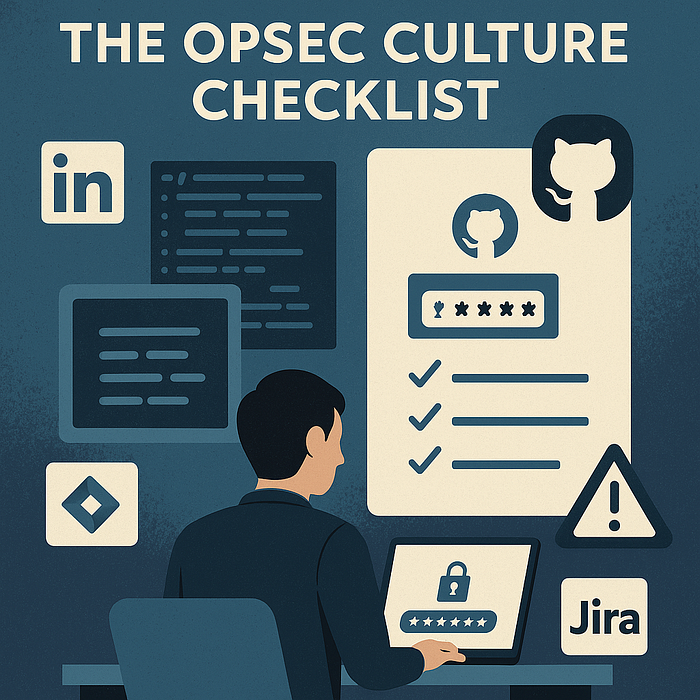Adversaries don't need to batter the door— they follow the breadcrumb trail you leave behind. A stray config here, a public API draft there, a boastful LinkedIn post about audit prep — stitch those up and you've got the map. You won't see it on a vulnerability scanner, but it still points straight to the keys that open your systems.
These aren't hypotheticals — I see them in real engagements. And they all come back to the same discipline: OPSEC. In my last piece, I called it the red team's most underrated tool. This time, I want to take a step back. OPSEC isn't just a pentester's checklist — it's an organizational culture. Without it, your org leaks intelligence faster than any scanner can find it. That's why posters and surface awareness tips aren't enough — because OPSEC culture shapes what adversaries see long before the first probe.
Why Awareness Posters Aren't Enough
"Don't reuse passwords." "Lock your screen." Those are awareness posters. OPSEC culture goes further: it's about recognizing that every detail has context. A repo commit, a training announcement, or a compliance press release tells adversaries where you're focused — and where you're distracted
Red teams practice OPSEC to avoid burning infrastructure. Organizations need OPSEC to avoid burning themselves.
Turning OPSEC Into a Checklist
Not a theory list. Not just "security's job." These are the habits and checks I've seen work, with owners clearly mapped so they don't die in a vacuum.
Day-to-Day Habits
☐ Credentials (IT / IAM / SOC)
- Breach monitoring is active for corporate emails
- MFA enforced everywhere
- Test accounts are tagged and rotated after use
☐ Internal Data (Dev / AppSec / Product Owners)
- No configs, keys, or stack traces in Jira/Confluence
- Secret scanning in repos (CI/CD gate)
- Logs are sanitized before they enter shared tools
☐ Public Noise (Comms / HR / Security Awareness)
- No internal project names, screenshots, or timelines posted on LinkedIn
- Metadata scrubbed from docs before external sharing
- Client/project details reviewed by Comms before publication
☐ Access Discipline (IT / Team Leads / DevOps)
- "Need to know" enforced on wikis, ticketing, and chat
- Stale accounts expired quickly (HR exit + IAM sync)
- Staging/test environments hardened like prod
☐ DNS & Domains (SOC / Threat Intel)
- Typo-squat monitoring active
- Takedown process documented with registrar/vendor
- Suspicious domains correlated with traffic or phishing attempts
☐ Reinforcement (HR / Security Awareness / Team Leads)
- OPSEC scenarios included in training (with real-world examples)
- Checklist part of new-hire onboarding
- Quarterly recognition for teams that prevent or flag leaks
☐ Drills (Security Leadership / IT / Management)
- Tabletop scenarios start with OPSEC lapses (leaked key, overshared audit)
- Escalation paths documented in playbooks
- Metrics tracked: mean time to revoke, mean time to notify
Artifacts, not assertions. Each line above should result in something you can paste into a ticket: a report, a screenshot, a log, a drill result.
Where Organizations Overshare (Without Realizing It)
The most overlooked OPSEC exposures aren't hidden in code. They're often in plain sight:
- The success story that gave away timing A vendor posted about delivering ISO 27001 prep for a client. Great marketing — but it also revealed the audit window and that controls were in a state of flux. Perfect timing intelligence.
- The training post that mapped the stack A dev team shared they'd just finished secure coding training. In the details, the stack was named. Now, adversaries know which frameworks are in play.
- The certification celebration with too much detail A financial org's SOC 2 press release listed vendors and monitoring tools. Cross-reference with CVEs, and an attacker suddenly has a roadmap of what to probe.
None of these posts was malicious. They were normal "corporate comms." But to an adversary, they're breadcrumbs. OPSEC culture doesn't mean "don't share" — it means share with intent.
Ownership Is Messy (And That's Fine)
Who owns OPSEC? Security? IT? HR? Comms? The reality: everyone leaks intel.
If only SOC cares, product overshares. If only devs care, comms burns them on LinkedIn. The fix is distributed ownership. Assign champions in each function, connect them regularly, and make OPSEC checks visible in risk reviews.
Culture isn't top-down. It's cross-functional.
Making OPSEC Visible
Culture dies if it isn't tracked. Bake OPSEC into what already exists:
- Add OPSEC exposures to risk registers and threat models.
- Measure "time to revoke" or "time to takedown" just like you measure patching SLAs.
- Include OPSEC lapses in post-mortems, even when they weren't the root cause.
If employees never see OPSEC tracked, they'll assume it doesn't matter.
OPSEC isn't about secrecy. It's about stopping everyday details from turning into an attacker's roadmap.
A culture checklist isn't optional. It's how you shut down leaks before the first scan even begins.

